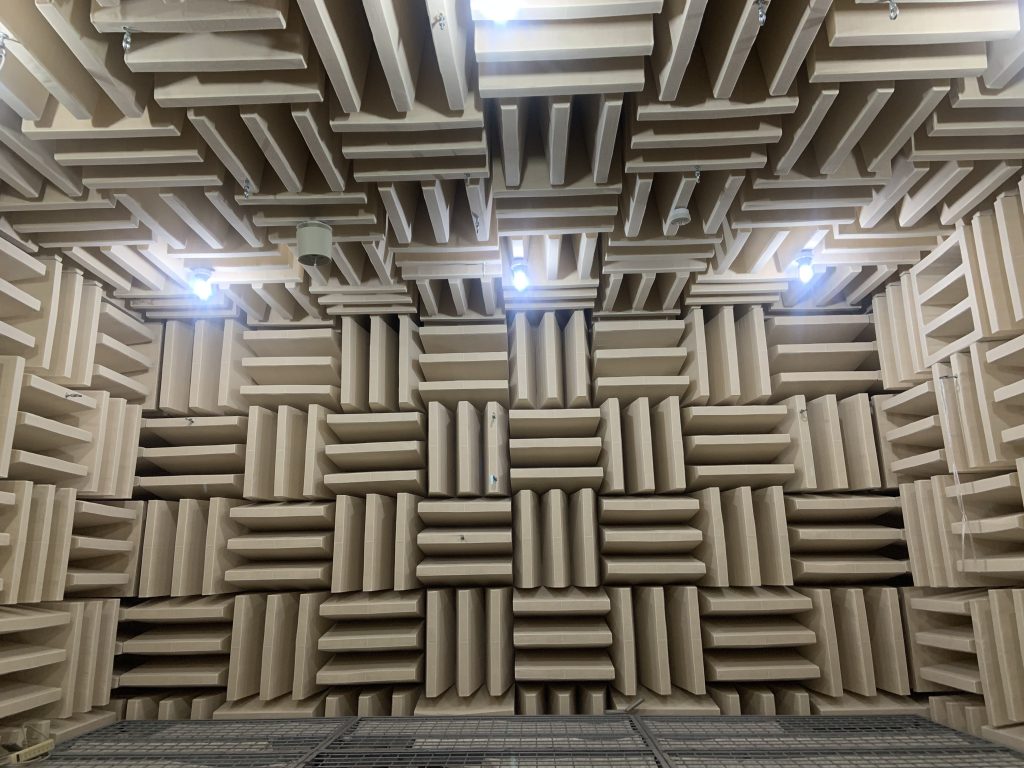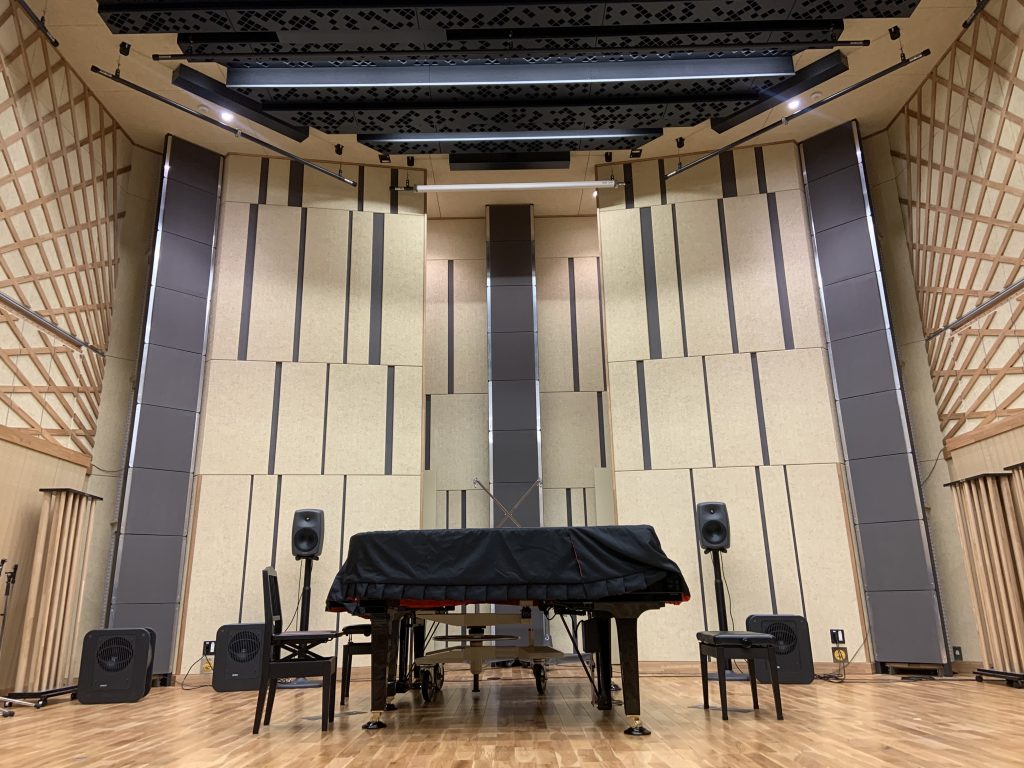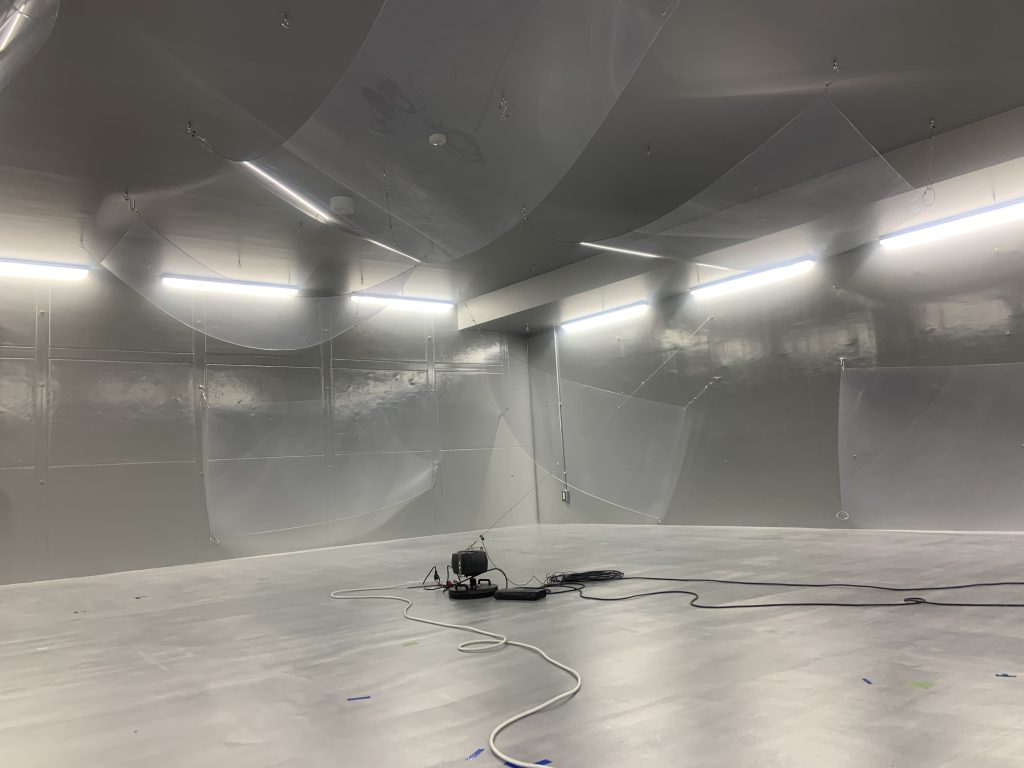
The Acoustic Research Center, Faculty of Design, Kyushu University is a notable building situated near Building 3 at Ohashi Campus, renovated in 2021. It consists of three floors, each serving a distinct purpose. The primary facility on the first floor is a Reverberation Room, on the second floor is a Recording Studio, and on the third floor is an Anechoic Room. These are frequently used by students, particularly those enrolled in the Acoustic Design course, for both educational purposes and their own research endeavors. The facilities are also available for general use, enabling various events and activities.
I am Kana Kusumi, majoring in Acoustic design. I would like to introduce each room.
The Anechoic Room is designed to eliminate sound reflections. The walls are constructed with materials that effectively absorb sounds. I have personally utilized this room during a class to record sample sounds. The unique feature of this room lies in its ability to capture original sounds devoid of reflections and ambient noise. The room is also used for examining the directivity and frequency response of loudspeakers.
The Recording Studio primarily serves the purpose of music and sound art productions. The facility has lofty ceiling and expansive wall area, which has enough space for active use. Despite this spaciousness, sound reverberation time is low and dry sound can be recorded. Furthermore, the inclusion of acoustic columnar diffusers within the room allows for the manipulation of sound echoes. This versatility allows the studio to host small concerts.
The Reverberation Room is characterized by the effect of inducing long reverberation The shape of the room is not square to allow the energy of the sound to travel from various directions. The room also features walls designed to minimize sound absorption. The room is often used for measuring the sound absorption coefficient of acoustical materials, which is important for the acoustic design of concert halls and the evaluation of sound absorption properties of materials used in car interiors.
The Acoustic Research Center significantly enhances the learning and studying environment for students. The students, especially in the Acoustic Design course, are proud of the facilities. Such well-equipped facilities are very rare in Japanese universities.
In addition, in the Acoustic Design course, you can study sounds from a variety of perspectives, including sound culture, acoustic environmental engineering, and acoustic information science. That is also one of the compelling reasons that motivated me to enroll in Geiko. My school life is so exciting on the Ohashi campus, and I appreciate my school environment very much.
* The pictures from the top are The Anechoic Room, The Recording Studio, and The Reverberation Room.
About the writer
Kana Kusumi
I am a master’s first-year student in the Acoustic Design Course at the Graduate School of Design. I am learning English and Danish to study abroad in Denmark after graduation. Since becoming a Geiko student supporter, I enjoy interacting with various international students. If you have any problems with the language, please let me know! I can help to translate or be your interpreter!
I am Kana Kusumi, majoring in Acoustic design. I would like to introduce each room.
The Anechoic Room is designed to eliminate sound reflections. The walls are constructed with materials that effectively absorb sounds. I have personally utilized this room during a class to record sample sounds. The unique feature of this room lies in its ability to capture original sounds devoid of reflections and ambient noise. The room is also used for examining the directivity and frequency response of loudspeakers.
The Recording Studio primarily serves the purpose of music and sound art productions. The facility has lofty ceiling and expansive wall area, which has enough space for active use. Despite this spaciousness, sound reverberation time is low and dry sound can be recorded. Furthermore, the inclusion of acoustic columnar diffusers within the room allows for the manipulation of sound echoes. This versatility allows the studio to host small concerts.
The Reverberation Room is characterized by the effect of inducing long reverberation The shape of the room is not square to allow the energy of the sound to travel from various directions. The room also features walls designed to minimize sound absorption. The room is often used for measuring the sound absorption coefficient of acoustical materials, which is important for the acoustic design of concert halls and the evaluation of sound absorption properties of materials used in car interiors.
The Acoustic Research Center significantly enhances the learning and studying environment for students. The students, especially in the Acoustic Design course, are proud of the facilities. Such well-equipped facilities are very rare in Japanese universities.
In addition, in the Acoustic Design course, you can study sounds from a variety of perspectives, including sound culture, acoustic environmental engineering, and acoustic information science. That is also one of the compelling reasons that motivated me to enroll in Geiko. My school life is so exciting on the Ohashi campus, and I appreciate my school environment very much.
* The pictures from the top are The Anechoic Room, The Recording Studio, and The Reverberation Room.
About the writer
Kana Kusumi
I am a master’s first-year student in the Acoustic Design Course at the Graduate School of Design. I am learning English and Danish to study abroad in Denmark after graduation. Since becoming a Geiko student supporter, I enjoy interacting with various international students. If you have any problems with the language, please let me know! I can help to translate or be your interpreter!






